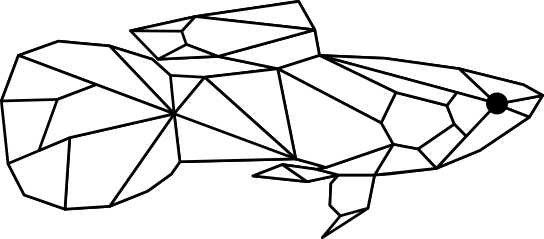
Cross 6
Purpose: Backcross to restore the snow white phenotype.
Male (Gandalf):
Bought from a big box store during February 2023 as part of the initial stock.
Strain: Snow White
Relevant genes. Some are assumptions, indicated with italics. Although their decedents strongly support the claims:
Base body color: Blond (bb)
Magenta: likely homozygous (MM)
European Blau: (rr)
Stoerzbach: (ss)
Nigrocaudatus: (XⁿᶦᴵY)
Female (C1AF):
Gandalf’s daughters from Cross 1 (I used 2 total females).
Strain: Half Snow-White
Relevant genes. Some are assumptions, indicated with italics. Although their decedents strongly support the claims:
Base body color: Gray (Bb)
Magenta: likely a carrier (Mm)
European Blau: (Rr)
Stoerzbach: (Ss)
Nigrocaudatus: likely heterozygous (XᴺᶦᴵXⁿᶦᴵ)
Offspring:
Born: Several Batches between November 2023 and December 2023.
Brood Size: 88
40 Male
48 Female
Offspring phenotypes and genotypes:
The figure above shows all the male phenotypes ordered by the relevent genes that showed an obvious phenotype. Base body color, European Blau, stoerzbach and Nigrocaudatus I (halfblack): I will use the grid as my grouping labels.
The females followed a similar phenotype distribution except for stoerzbach. I had a hard time telling apart females that expressed stoerzbach or not.
Genotype distributions. Numbers indicate the distribution with-in just the males.
A1: Bb|(MM or Mm)|Rr|Ss|XᴺᶦᴵY, 7 males, 17.5%
B1: Bb|(MM or Mm)|Rr|ss|XᴺᶦᴵY, 5 males, 12.5%
C1: Bb|(MM or Mm)|rr|Ss|XᴺᶦᴵY, 7 males, 17.5%
D1: Bb|(MM or Mm)|rr|ss|XᴺᶦᴵY, 1 male, 2.5%
A2: Bb|(MM or Mm)|Rr|Ss|XⁿᶦᴵY, 0 males, 0%
B2: Bb|(MM or Mm)|Rr|ss|XⁿᶦᴵY, 3 males, 7.5%
C2: Bb|(MM or Mm)|rr|Ss|XⁿᶦᴵY, 0 males, 0%
D2: Bb|(MM or Mm)|rr|ss|XⁿᶦᴵY, 1 male, 2.5%
A3: bb|(MM or Mm)|Rr|Ss|XᴺᶦᴵY, 2 males, 5%
B3: bb|(MM or Mm)|Rr|ss|XᴺᶦᴵY, 1 male, 2.5%
C3: bb|(MM or Mm)|rr|Ss|XᴺᶦᴵY, 2 males, 5%
D3: bb|(MM or Mm)|rr|ss|XᴺᶦᴵY, 1 male, 2.5%
A4: bb|(MM or Mm)|Rr|Ss|XⁿᶦᴵY, 2 males, 5%
B4: bb|(MM or Mm)|Rr|ss|XⁿᶦᴵY, 3 males, 7.5%
C4: bb|(MM or Mm)|rr|Ss|XⁿᶦᴵY, 2 males, 5%
D4: bb|(MM or Mm)|rr|ss|XⁿᶦᴵY, 3 males, 7.5%
My expectation was that each of the 16 unique phenotypic combinations (resulting from four genes) would represent roughly 6.25% (indicated by the dotted line) of the offspring. This is because the C1A female is heterozygous for each gene, while Gandalf is homozygous. This means each individual gene should show an even 50% distribution of its two phenotypes. At first glance, the overall phenotypic distribution seemed skewed towards A1, B1, and C1. However, after examining the distributions of each gene individually, the picture becomes much clearer:
Base Body Bolor: 43 Blond : 45 Gray (Both males and females)
European Blau (EB): 48 EB : 40 Non-EB (Both males and females)
Halfblack: 44 Halfblack : 44 Non-Halfblack (Both males and females)
Stoerzbach: 17 Stoerzbach : 23 Non-Stoerzbach (These values reflect males only)
As anticipated, for genes where C1A is heterozygous and Gandalf is homozygous, we expected a near 50% split between the two phenotypes. And as you can see, the individual gene distributions align remarkably well with this expectation!
Notes:
I intentionally didn't focus heavily on magenta gene expression in this cross. The variety of phenotypes already present was extensive, and adding magenta to the analysis would have introduced significant complexity. However, given that magenta is incompletely dominant and Gandalf is likely homozygous (MM) for the gene, all offspring would inherit at least one magenta allele. C1AF, being Gandalf's daughter, is likely heterozygous (Mm) since her mother from Cross 1 (Female #1) probably lacked the magenta gene. Therefore, all offspring in this brood are either MM or Mm. Based on color alone, these phenotypes should be largely indistinguishable. Fin size, however, is a different matter. Magenta is thought to reduce fin size. I believe this largely occurs in its homozygous state, which aligns with its incomplete dominance. While I didn't collect specific fin size data for this brood, I do recall observing both long-finned and short-finned males. Without precise data, a proper distribution analysis isn't possible at this time.
The halfblack trait exhibited a 50% distribution in both males and females in this brood, which provides strong evidence for X-linkage. This indicates that the C1A female was indeed heterozygous for the halfblack gene. As a result, all halfblack female offspring produced here are also heterozygous. This suggests that if you breed any halfblack male offspring from this group, all their female progeny are expected to display the halfblack trait, though this hypothesis requires further testing.
I selected three females with a phenotype closest to snow white as breeders for the next cross. These females were paired with the C5AM male from Cross 5, establishing Cross 11. These females were labeled Cross 6 Female A (C6AF).
A YouTube video detailing the start of Cross 6 can be found here.
C6AF





